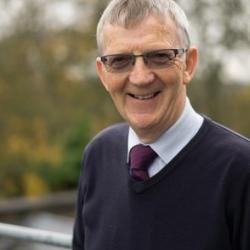Publications
Biography:
Rod Lynch's research background was in chemistry and instrumentation science before moving into environmental geotechnics. After graduation in chemistry from Birmingham University, he researched solid state structures at Mullard Research Laboratories; oil additives at Esso Research; nuclear magnetic resonance and solid state structures at Warwick University where he obtained his PhD in Molecular Sciences specialising in spectroscopy. After teaching and instrumental research at Durham University he joined Philips / Pye Unicam as a project engineer on chemical instrument research and development, and eventually became Principal Scientist. He led the team which developed the first liquid chromatography diode array detector, from a research idea generated by the Philips Research Labs in Eindhoven. In 1995 he joined the Geotechnical Group at CUED where he was Senior Technical Officer in environmental geotechnics until retirement in September 2011. From 1996 –2001, he was leader of the Sensors and Imaging Working Group of NECER, a European Union-funded network of geotechnical centrifuge users studying environmental projects. After retirement he continued to collaborate with Prof Abir Al-Tabbaa, to advise her students and to supervise 4th year project students at CUED. In 2015 he became Course Director of the Centre for Doctoral Training for Future Infrastructure and Built Environment.
Environmental geotechnics research
Focussed mainly on contaminated land issues, in particular the remediation of contaminated soil and groundwater:
- organic and inorganic pollutant plume tracking in kaolin using the minidrum centrifuge,
- a fibre-optic pH sensor for groundwater monitoring,
- electro-osmotic dewatering of clays,
- a probe for detecting NAPL pollutants in soils,
- remediation of contaminated land by electrokinetics,
- the control of plumes in groundwater using airsparging,
- preventing efflorescence in brickwork,
- tracking of contaminants through landfill liners by fibre-optic sensors,
- in-situ groundwater clean-up using photocatalysis,
- containment or exclusion of pollutants by an electrokinetic barrier,
- studies of pollution plume breakthrough in soils using in-situ fibre-optic sensors,
Instrumentation
- Avalanche detection devices
Teaching
- Part IIB examiner (Projects). Coordinator for civil, structural and environmental 4th year projects.
- 4D14 Contaminated and and waste containment (chemistry)
- Supervisor of 3 PhD students and a large number of MEng projects
- PhD Examiner in Cambridge, DTU Denmark and Cagliari Italy
Collaborations
University of Cagliari, Italy. Dept of Civil and Environmental Engineering (Prof. Aldo Muntoni)
Through the EU Erasmus student exchange scheme from 2005-11, ten Italian students from Cagliari University have each carried out 6 month projects on groundwater clean-up, permeable reactive barriers, prevention of brickwork efflorescence or contamination protection of groundwater.
2011: Maria Elena Lusci, Valentina Filia 2010: Daniela Spiga, Marco Laconi 2009: Roberto Lo Mastro, Simone Cossedu 2008: Alessandro Sidore, Mario Uda 2007: Nicola Giuliani, Emmanuela Contini 2006: Alice Meloni
Strathclyde University, Civil Engineering Dept. (Dr Philippe Sentenac)
Shrinkage of landfill liners by solvents
Wakayama College of Technology, Japan (Prof. Seiichi Sasaki)
Contaminant transport of heavy metals through soils
Key Publications
See my publications list


